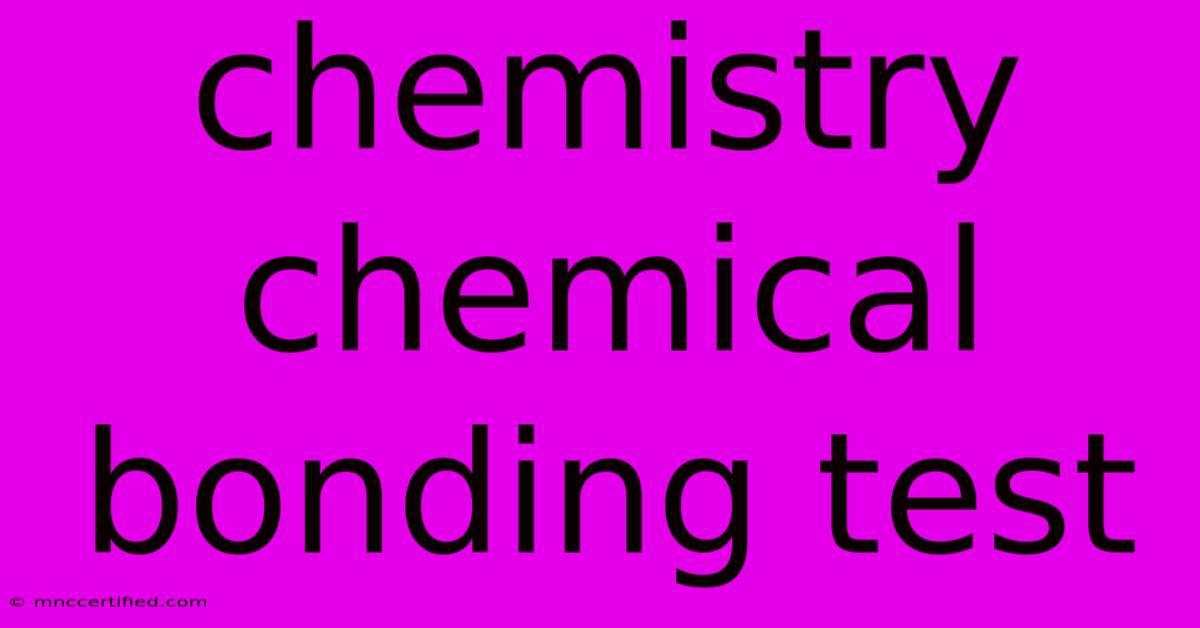Chemistry Chemical Bonding Test

Table of Contents
Ace Your Chemistry Exam: A Comprehensive Guide to Chemical Bonding Tests
Preparing for a chemistry exam focusing on chemical bonding can be daunting. This comprehensive guide provides a structured approach to mastering this crucial topic, helping you ace your test and solidify your understanding of chemical bonding. We'll cover key concepts, effective study strategies, and practice resources to ensure you're fully prepared.
Understanding Chemical Bonding: Key Concepts to Master
Chemical bonding is the heart of chemistry, explaining how atoms interact and form molecules and compounds. To succeed in your test, you must thoroughly grasp these core concepts:
1. Types of Chemical Bonds:
-
Ionic Bonds: These bonds form through the electrostatic attraction between oppositely charged ions. Understand the process of electron transfer, resulting in cations (positively charged ions) and anions (negatively charged ions). Know how to predict ionic bond formation using electronegativity differences. Keywords: ionic bond, electronegativity, cation, anion, electrostatic attraction, electron transfer.
-
Covalent Bonds: Formed by the sharing of electrons between atoms. Learn about different types of covalent bonds: single, double, and triple bonds. Understand the concept of polarity and how it influences molecular properties. Keywords: covalent bond, electron sharing, single bond, double bond, triple bond, polarity, nonpolar, polar.
-
Metallic Bonds: Characteristic of metals, where valence electrons are delocalized and form a "sea" of electrons surrounding positively charged metal ions. This accounts for metals' unique properties like conductivity and malleability. Keywords: metallic bond, delocalized electrons, sea of electrons, conductivity, malleability.
2. Lewis Structures & VSEPR Theory:
Mastering Lewis structures is critical for visualizing chemical bonds. Practice drawing Lewis structures for various molecules and ions. Understanding the Valence Shell Electron Pair Repulsion (VSEPR) theory will help you predict molecular geometry and bond angles. Keywords: Lewis structures, VSEPR theory, molecular geometry, bond angle, lone pair, electron domain.
3. Intermolecular Forces:
These forces exist between molecules and significantly influence physical properties like boiling point and melting point. Understand the differences between:
- Hydrogen bonds: Strong intermolecular forces involving hydrogen bonded to highly electronegative atoms (N, O, F).
- Dipole-dipole interactions: Occur between polar molecules.
- London Dispersion Forces (LDFs): Weakest intermolecular forces, present in all molecules.
Keywords: hydrogen bond, dipole-dipole interaction, London Dispersion Forces (LDFs), intermolecular forces, boiling point, melting point.
Effective Study Strategies for Chemical Bonding
Effective studying is key to success. Here's a structured approach:
-
Review your class notes and textbook: Focus on key concepts and definitions. Create flashcards for important terms and concepts.
-
Practice, practice, practice: Work through numerous practice problems. Start with easier examples and gradually increase the difficulty. Use online resources and textbooks for extra problems.
-
Use diagrams and models: Visual aids are incredibly helpful for understanding chemical bonding. Draw Lewis structures, and use molecular models to visualize 3D structures.
-
Form study groups: Collaborating with classmates can enhance your understanding and identify areas where you need further clarification.
-
Seek help when needed: Don't hesitate to ask your teacher or professor for clarification on concepts you find challenging.
Resources for Chemical Bonding Practice
Numerous resources are available to help you practice and solidify your understanding of chemical bonding:
- Online quizzes and practice tests: Many websites offer quizzes and practice tests on chemical bonding.
- Chemistry textbooks and workbooks: These provide comprehensive coverage of the topic and include numerous practice problems.
- Khan Academy: Offers free online courses and tutorials on various chemistry topics, including chemical bonding.
- Your teacher or professor: Don't underestimate the value of seeking help from your instructor. They can provide valuable guidance and feedback.
Conquer Your Chemistry Exam
By understanding the core concepts of chemical bonding, utilizing effective study strategies, and leveraging available resources, you can confidently approach your chemistry exam. Remember that consistent effort and practice are crucial for success. Good luck!

Thank you for visiting our website wich cover about Chemistry Chemical Bonding Test. We hope the information provided has been useful to you. Feel free to contact us if you have any questions or need further assistance. See you next time and dont miss to bookmark.
Featured Posts
-
Steelers Browns Final Score Cleveland Results
Nov 22, 2024
-
247 Sports Julian Lewis Joins Colorado
Nov 22, 2024
-
Storm Bert Amber Warning Transport Scotland
Nov 22, 2024
-
Pierss Reaction To Ellens Departure
Nov 22, 2024
-
Icc Warrants Netanyahu Gallant And
Nov 22, 2024